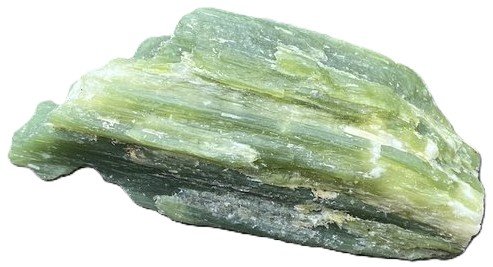
Tremolite takes its name from the Tremola Valley in Switzerland, where researchers first identified it. In the 18th century, German mineralogist Johann Georg Albrecht Höpfner named the mineral. As part of the amphibole group of silicate minerals, its name highlights both its geological origins and crystalline structure
Composition and Formation
Tremolite is a calcium-magnesium silicate mineral with the chemical formula Ca₂Mg₅Si₈O₂₂(OH)₂. It forms in metamorphic environments, particularly through the alteration of dolomitic limestone and other calcium-rich rocks subjected to high temperatures and pressures.
Tremolite occurs in various colours, including white, grey, green, and even lavender, depending on trace element inclusions. The presence of iron transforms tremolite into actinolite, a darker green variety. The fibrous form of tremolite is classified as a type of asbestos, which has significant industrial implications.
Locations and Sources
Tremolite is found in numerous locations worldwide. Some of the most notable sources include:
- Switzerland – The Tremola Valley, where it was first discovered.
- Italy – Notable for high-quality crystal specimens.
- Canada – Quebec and Ontario have significant deposits.
- USA – Found in New York, California, and North Carolina.
- Pakistan, Afghanistan, and Myanmar – Known for their gem-quality tremolite specimens.
Physical Characteristics
- Colour: Ranges from white, grey, and green to lavender and yellowish hues.
- Lustre: Silky to vitreous, depending on crystal formation.
- Hardness: 5 – 6 on the Mohs scale, making it relatively soft compared to other silicates.
- Crystal System: Monoclinic.
- Transparency: Can be translucent to opaque, with some high-grade specimens exhibiting a slight glow.
- Cleavage: Exhibits perfect cleavage, which makes it prone to breaking along certain planes.
In its fibrous form, tremolite is a known asbestos mineral, raising health concerns when inhaled. Non-fibrous tremolite is safe to handle and is used as a gemstone.
Archaeological Finds and Historical Usage
Due to its fragile nature, Tremolite saw little use in ancient artefacts. However, its asbestos varieties once served as fire-resistant textiles and insulation. Some indigenous cultures wove asbestos fibres into cloth for both ceremonial and practical purposes.
Gem-quality tremolite, primarily sourced from Pakistan and Myanmar, has gained popularity in jewellery. Transparent, lavender, or greenish specimens are crafted into cabochons or faceted stones for collectors.
Modern Applications
Although fibrous tremolite asbestos poses health risks and is largely phased out, non-fibrous tremolite remains valued by mineral collectors and lapidary artists. Some of its modern uses include:
- Gemstone trade – High-quality tremolite is shaped into decorative stones.
- Metaphysical healing – Crystal practitioners use it for emotional and spiritual work.
- Research and education – Mineralogists and geologists study tremolite to understand metamorphic processes.
Interesting Facts
- Tremolite is structurally related to actinolite and nephrite jade. In fact, many white or pale green nephrite jades contain tremolite as a primary component.
- Some tremolite specimens exhibit a “cat’s eye” effect due to fibrous inclusions, making them desirable in jewellery.
- Despite its hazardous asbestos form, tremolite’s massive, non-fibrous variety is completely safe to handle.
Folklore, Legends, and Tales
Though tremolite lacks the historical prominence of other gemstones, many associate it with transformation and spiritual awakening. Metaphysical traditions credit it with enhancing clarity, insight, and personal growth. In cultures that revere jade, people regard tremolite-bearing specimens as sources of protection and healing energy.
Links with Astrology and the Chakra System
Astrology
Tremolite connects to the zodiac signs Virgo and Capricorn, both known for discipline, focus, and transformation—qualities that many believe tremolite amplifies.
Chakra System
Third Eye Chakra: Stimulates intuition and insight.g stone of strength and endurance.
Heart Chakra (Green Tremolite): Promotes emotional healing and compassion.
Crown Chakra (White or Lavender Tremolite): Enhances spiritual awareness and connection to higher consciousness.
